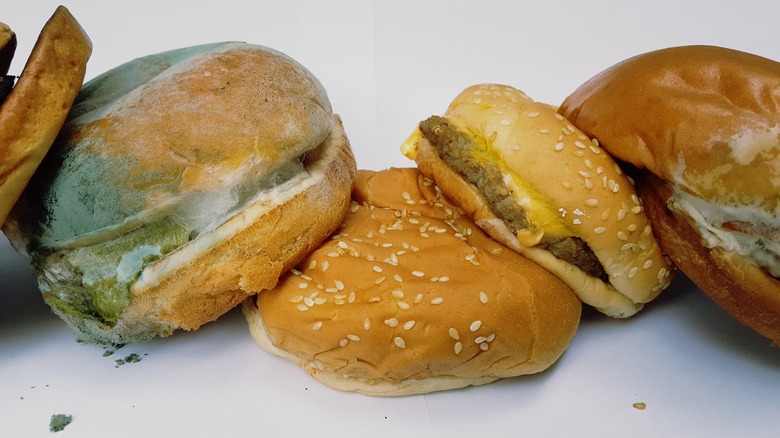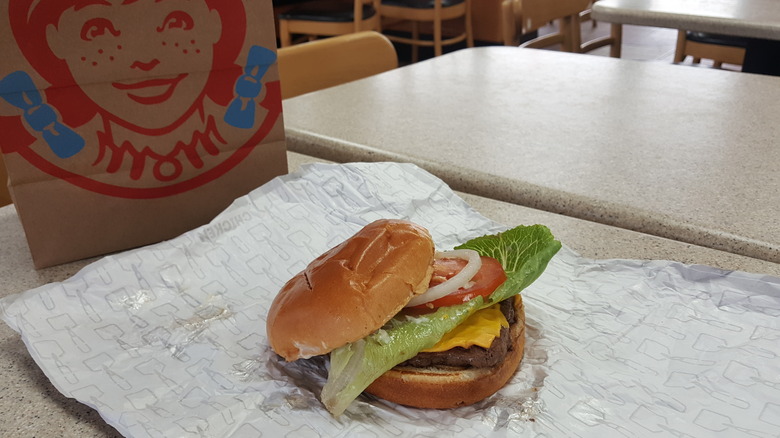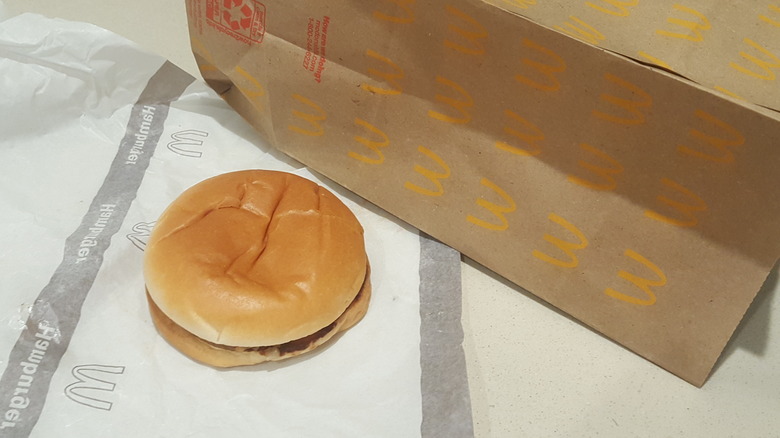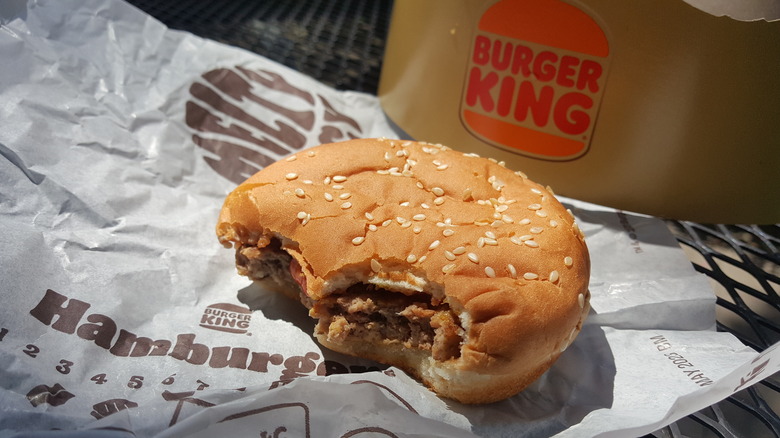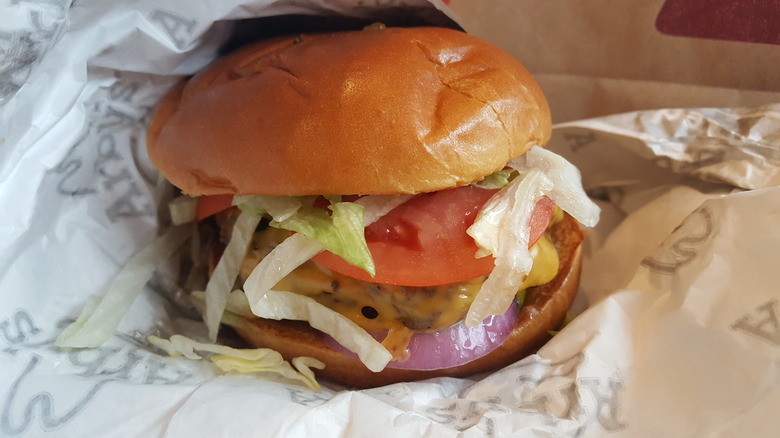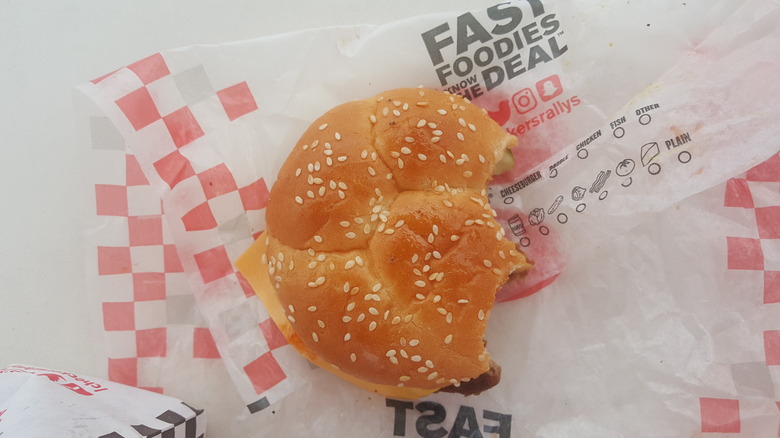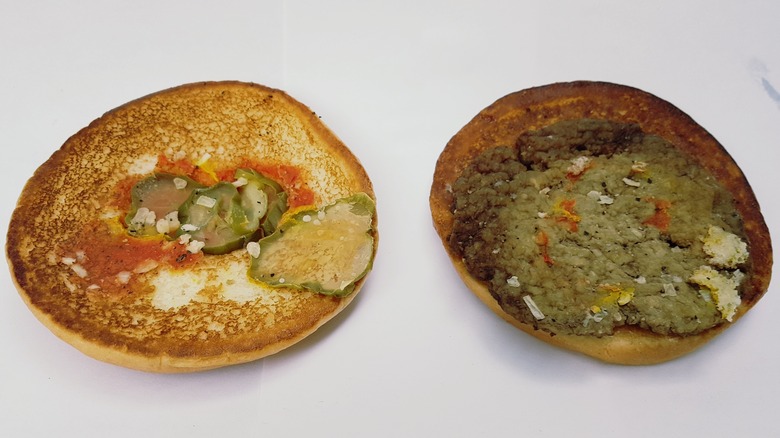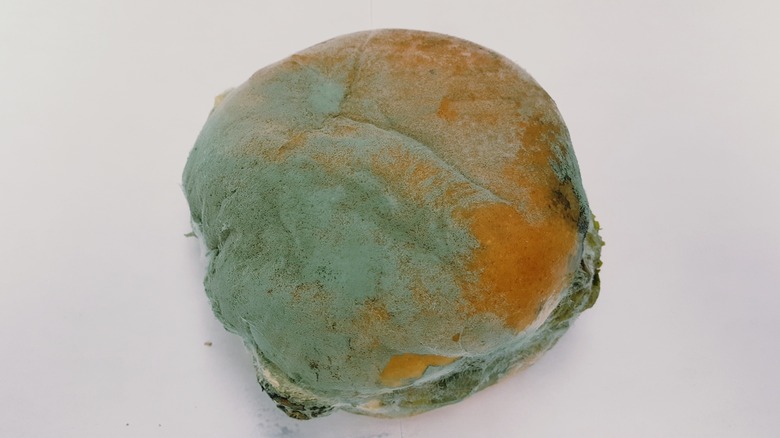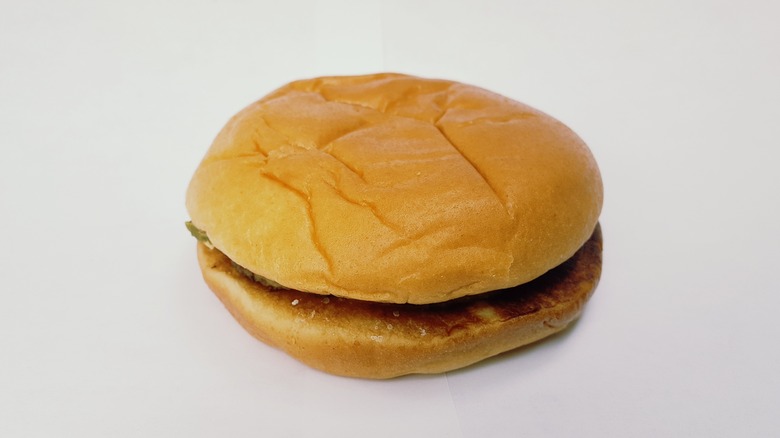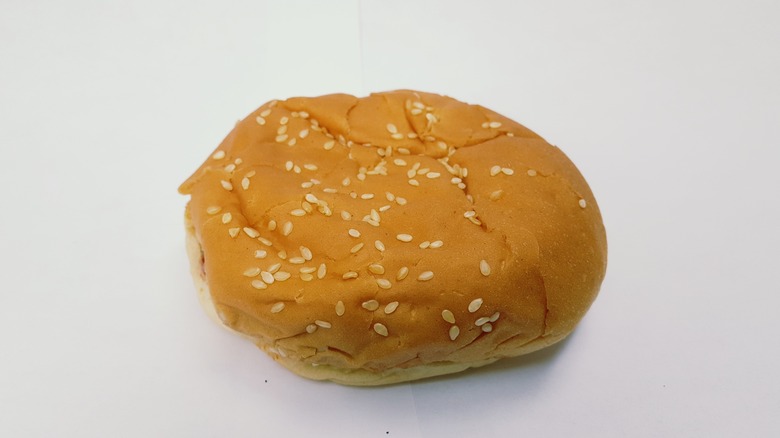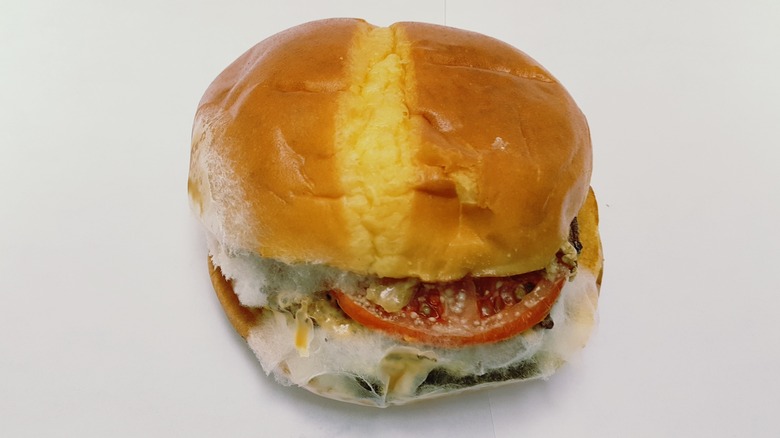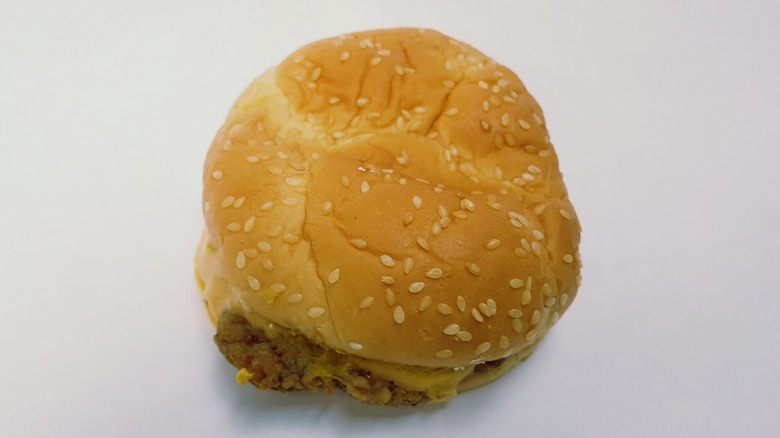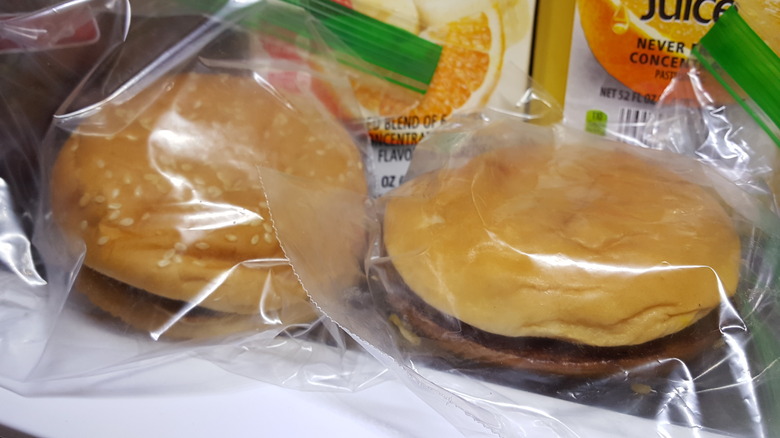Here's How Long It Takes Fast Food Burgers To Go Bad
You can't always eat a burger the moment it comes off a grill. This might make you wonder how quickly it will go bad. Here's the scenario: You're headed home after a long day at work. You go to the drive-thru because today cooking is out of the question. The trip home will take you another 20 minutes, though, and you're not sure when the rest of the family will get back. You need to know if your burgers will go bad if you leave them on the counter while you take a rejuvenating, muscle-relaxing, head-clearing bath.
The first issue is that burgers don't taste the same when they've hung around for a while as they do when they're fresh off the grill. There's a loss in quality, so you'll need to calculate if the convenience is worth it. Furthermore, these meaty sandwiches can become spawning grounds for dangerous pathogens if too much time goes by without chilling them. In the fridge, burgers will last longer, but not indefinitely. Finally, take a moment to consider what would happen if no one eats the burgers in the bag on the counter, everyone forgets about them, and then you find them a week later. What new horrors would you uncover in the depths of that stinking bag? We tested how burgers from a variety of fast food chains stood up to stints on the counter and in the fridge so you can know what happens to them when they're neglected.
How long it takes a Wendy's hamburger to lose top-quality
Here's what it's like to eat a Wendy's burger straight off the grill: It starts with a hot, meaty, square patty covered in melty, gooey cheese. That melted mess mixes with tangy ketchup and creamy mayo. The pickles crowning it add a vinegary zing and a bit of crunch. Crisp, fresh lettuce, tomatoes, and onions on top create the perfect contrast to the heat from the grill. The kitchen has encased everything in a sweet, soft bun. When you bite in, you feel the crunch of the vegetables against your teeth, which then sink into the tender, beefy patty. The beef is not overdone — it may even be a bit on the pink side — and it's more than worth the $6 price tag (prices may vary depending on location).
Eat that same burger ten minutes later and the experience is not the same. The temperature has diminished and flavors have worsened proportionately. The vegetables have started wilting. In half an hour the decline in quality is even more noticeable — the beef has gotten a little chewy and the only crunch left comes from the pickles. It's still edible, even good, but if you're eating this burger 30 minutes after you bought it, you're losing out. Don't wait to get home. Sit down in Wendy's and dig into this burger as it was meant to be devoured.
How long it takes a McDonald's hamburger to lose top-quality
The quality of a McDonald's regular hamburger isn't high to begin with. You get what you pay for and this sandwich only costs around $2 — much cheaper than most of the competition. Bite in just seconds after the employee hands it over to you and the meat patty is already chewy and overdone. Although toasted, the bun isn't fluffy or crisp, just plastic-like with dry edges and top. It's an underwhelming experience, but at least the Golden Arches serves its burgers nice and hot.
This unattractive fast food offering has one thing going for it, though — it doesn't matter if you eat it right away. Sure, your sandwich will lose some temperature, but even after zapping it in the microwave for 35 seconds, the texture is just about the same as when it was first served. In fact, Chrissy Teigan famously buys McDonald's cheeseburgers in bulk, stores them in the fridge, and reheats them later when the craving strikes.
The pickle flavor is the only aspect that changes over time. It gets stronger, more unpleasant, and a little wonky. If you can't deal with that, either eat your burger right away or go to a different drive-thru.
How long it takes a Burger King hamburger to lose top-quality
Bite into a Burger King sandwich just after your server hands it over and it's something like an explosion. The chain puts plenty of sauces on its burgers, so when you sink your teeth in, a mixture of ketchup, mustard, and pickle flavor squirts onto your tongue. It's so intense that you can barely taste the beef patty tucked into the pleasantly sweet, fluffy bun. The temperature is perfect, not hot enough to burn you, but rather pleasingly toasty. You get great value for the $2 price.
Wait as little as 15 minutes to dig in and the experience is significantly less satisfactory. The meat is more noticeable, or at least the texture of it — it's rubbery now. The bread is soggy from the sauces and they no longer gush out when you bite in. The temperature isn't as nice. Burger King's sandwiches are at their best for the first few minutes after you get them, so the drive-thru there may not be your best bet.
How long it takes an Arby's hamburger to lose top-quality
As soon as you get your hand's on an Arby's burger, rip the foil wrapping off and dig in. This sandwich comes fully decked out with lettuce, tomato, onions, cheese, pickles, and Arby's sauce. The beef patty is seared, nearly burned on the outside, but buttery within. The only problem with the Wagyu burger is it's not as hot as it could be. All of the cold toppings cool down the sandwich a bit before it reaches the customer. That makes rapid consumption of the $7 sandwich even more imperative so it doesn't lose any more heat.
Of course, if you wait half an hour until you get home from Arby's drive-thru, your experience won't be the same. By that time the entire sandwich will be cold. The onion flavor will have invaded the rest of the sandwich and the other veggies will get droopy. It's just not as attractive as when it's recently served, but it's still edible.
How long it takes a Rally's hamburger to lose top-quality
When you unwrap your Rally's All American Cheeseburger, you'll notice that it's shiny from the grease coating it. Take a bite and this piping hot little burger with cheese tastes tremendous, especially if you consider that it only costs around $1.60 (at least in our area) — cheaper than every other burger mentioned in this article. There's no crunch to this burger, but the soft beef and cheese are satisfying on their own.
Half an hour later, this burger doesn't taste that much different from when you bought it, particularly if you give it a whirl in the microwave before digging in. The main difference is the bread seems to have absorbed most of the grease — an improvement. If you're looking for a burger that will last longer in storage, this one doesn't have fresh veggies to go droopy or an excessive slathering of sauce to make the bread soggy. It's the perfect cheap burger to buy in bulk for dinner and it won't get damp or chewy before everyone gets home. It's easy to reheat, and if you wanted, you could even set up a toppings bar with fresh tomatoes, lettuce, onions, and pickles. Suddenly you have the best combination: a cheap fast food burger that you can eat at home with veggies that still crunch.
When hamburgers can cause food poisoning
There's a difference between an unappetizing hamburger and a dangerous one. If you've left burgers out on the counter for your family to grab throughout the evening, they won't be as delicious as if everyone had eaten them straight off the grill. That's not necessarily a problem — some people are more focused on filling their rumbling tummies and less on enjoying the experience. The real problem is that those burgers on the counter could give everyone food poisoning if they remain unrefrigerated for too long.
According to the USDA's Food Safety and Inspection Service (FSIS) perishable food of any kind can only remain at room temperature for two hours. Any longer and it is not safe to eat because the conditions are prime for pathogens to prosper. So, if you pick up your burgers at 5:30, drive home 30 minutes, and set them on the counter, you'll need to stick them in the fridge before 7:30 to stay safe. The sooner the better. If the ambient temperature is above 90 degrees, refrigerate your sandwiches before an hour is up.
What happens when you leave a Wendy's burger out 10 days
Wendy's burgers were the most delicious when eaten right away and also the grossest of all after spending ten days in a plastic baggie in a dark cupboard. The famously square patty got moldy and soggy and an unpleasant smell emanated from the bag when it opened. The same veggies that gave this sandwich crunch and flavor when it was fresh created perfect conditions for mold to grow a few days later. Could it be that mold — or at least this gooey green variety — has similar food preferences as the author of this article?
The mold didn't show up quickly, though — it took a few days. The first signs of decay only appeared on day six in the cupboard. That's when the lettuce became a disgusting mess and green spots showed up on the tomato. By day eight, there was a light dusting of mold over the top bun. On day ten, the burger was thoroughly covered with fuzzy growth. In other words, you probably won't find something pleasant if you leave a bag of Wendy's burgers on the floor of your car and forget about them for a few days.
What happens when you leave a McDonald's burger out 10 days
The McDonald's hamburger was the least appetizing when fresh — the bun tasted like plastic. After spending a few days outside of the fridge, hidden away in a dark corner, it still looked artificial. This sandwich didn't show many signs of spoilage at all — it looked about the same as when it was purchased. The bun was still fluffy, with a sheen to it. Peering under the bun and at the interior of the sandwich uncovered the most telling signs of its age. The patty looked discolored and the pickles had drooped and shriveled.
These burgers don't have fresh veggies on them, which may be one reason they don't mold the way some others do. Some people might point to preservatives used by the chain, but according to McDonald's website, the restaurant's patties only contain beef, salt, and pepper. The buns contain dough conditioners, but no preservatives. For example, DATEM and ascorbic acid improve the texture and add volume while mono and diglycerides help the other ingredients mix more thoroughly. None of the mentioned additives lengthen shelf life though. Perhaps these burgers don't visibly spoil quickly because they are prepared in conditions far from pathogens and by people with clean hands.
What happens when you leave a Burger King burger out 10 days
The sandwich that gave Burger King its name doesn't give many visual signs of going bad after a long period left sitting at room temperature. Take a burger that's been left out for around ten days and compare it to a fresh one. You'll see that they look almost identical, except that the bun of the older sandwich has contracted a bit and lost its fluff.
Look under the bun, though, and you'll find another story. First, you'll notice the acrid, putrid smell. Also, the bun is incredibly moist — impossible to peel off the patty. Instead of bread, it feels almost like uncooked dough because there's so much humidity in it.
The mold-free state of Burger King's burger is not because of preservatives in the patties. The chain's website says these only contain beef with no additives. It's harder to know what goes in the bun since the website doesn't provide a current ingredient list. Calcium propionate, a preservative, does appear on an information pamphlet from 2008, though. The chain's recipe may have changed since then.
What happens when you leave an Arby's burger out 10 days
Over ten days, the burger from Arby's grew a beard of feathery, white mold. It was the first sandwich to show signs of spoilage. These wisps of mold appeared after just five days of being tucked away in a sandwich baggy. Somehow, though, even with mold on it, the bun still managed to look delicious.
The fresh toppings like tomatoes, onions, and lettuce on this sandwich likely contributed to the appearance of mold. Fungi love moisture and veggies have a lot. The other ingredients in this burger may or may not have played a part. Similar to other chains, patties from Arby's contain just beef. The buns use dough conditioners and food coloring, but nothing that could be considered a preservative. On a side note, red 40, yellow 5, yellow 6, and caramel color may be the reason why the bun looks so tempting, even after it's been aged.
An Arby's burger covered in mold is a tragic sight. Fresh, this sandwich is succulent. Seeing it spoil is heartbreaking. So, if you're headed to Arby's, buy only what you're planning to eat right away, because these burgers are too good to let go bad.
What happens when you leave a Rally's burger out 10 days
The cheese on a Rally's burger gets pretty gross after ten days go by. The rest of the sandwich shows few signs of its age. The bread looks pillowy soft and the edges of the patty poke out, the same brown color as always. The cheese, though, turns into a slimy, liquid substance. It looks like it's come to life and is trying to escape. That made it particularly unpleasant to open this sandwich baggy.
The texture of the cheese wasn't the only thing that changed. It also started stinking, but not in the way that expensive cheeses do. This was the unmistakable smell of a rotten dairy product.
It's not clear if Rally's puts preservatives or additives in its buns and burgers. The chain's website provides nutrition facts, but no ingredient list. Whether or not there are preservatives in this sandwich, it's clearly unfit to eat after ten days. Best to eat it hot while sitting next to the drive-thru on one of Rally's quaint picnic tables with umbrellas.
How long can you keep a burger in the fridge?
Keep a burger in the fridge for ten days and it still looks pretty fresh. Just take a gander at the photo above. There's Mcdonald's on the right and Burger King on the left. They look great, and if you open those baggies and take a whiff, you won't smell anything off-putting. You might think a quick spin in the microwave would get them ready for lunch. Their appearance is deceptive.
The FSIS recommends leaving cooked ground meat products in the refrigerator for up to four days. At ten days, these burgers have been around for more than twice the amount of time they should have. This is a great argument for labeling leftovers — they may look safe to eat for far longer than they actually are, and it's easy to forget how long you left them there.
Another alternative is sticking any uneaten burgers in the freezer. The FSIS says they'll remain edible for around four months there. Of course, whether or not you enjoy eating a frozen, thawed, and reheated burger can only be determined by trying it. You'll likely get better results if you remove lettuce, tomatoes, and any other fresh veggies on the burger before freezing or refrigerating.
